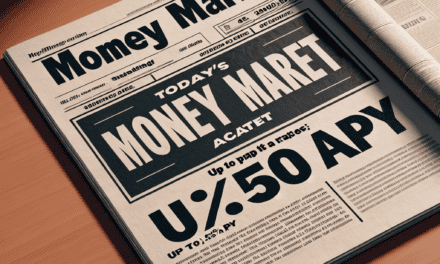“Trump’s Early Lead Ignites Market Rally: Stocks, Dollar, and Yields Soar”
Introduction
In the wake of early election results indicating a lead for former President Donald Trump, financial markets have experienced a notable surge. Investors, reacting to the potential implications of a Trump administration, have driven up stock prices, strengthened the U.S. dollar, and pushed bond yields higher. This market rally reflects optimism about Trump’s pro-business policies, including tax cuts and deregulation, which are anticipated to stimulate economic growth. As traders and analysts assess the evolving political landscape, the financial markets are responding with heightened activity, underscoring the significant impact of political developments on economic sentiment and investment strategies.
Impact Of Trump’s Early Lead On Global Stock Markets
As the news of Donald Trump taking an early lead in the elections spread, global stock markets experienced a significant surge, reflecting investor optimism and a renewed sense of confidence in the economic policies associated with his administration. This unexpected development has led to a notable rally in stocks, a strengthening of the U.S. dollar, and an increase in bond yields, all of which underscore the intricate relationship between political events and financial markets. Investors, who often seek stability and predictability, appear to be reacting positively to the prospect of a Trump administration, which is perceived to favor business-friendly policies, tax cuts, and deregulation.
In the immediate aftermath of the news, major stock indices around the world responded with enthusiasm. The Dow Jones Industrial Average, S&P 500, and NASDAQ all posted gains, reflecting a broad-based rally across various sectors. This upward momentum was not confined to the United States alone; European and Asian markets also experienced a boost, as investors anticipated a continuation of policies that could stimulate economic growth and corporate profitability. The financial sector, in particular, saw substantial gains, driven by expectations of deregulation and potential interest rate hikes that could enhance bank profitability.
Simultaneously, the U.S. dollar strengthened against a basket of major currencies, as investors flocked to the perceived safety and potential returns of American assets. A stronger dollar often indicates confidence in the U.S. economy and can have far-reaching implications for global trade and investment flows. While a robust dollar benefits American consumers by making imports cheaper, it can pose challenges for U.S. exporters by making their goods more expensive abroad. Nevertheless, the immediate market reaction suggests that investors are prioritizing the potential for domestic economic growth over concerns about trade imbalances.
In addition to equities and currencies, bond markets also reacted to Trump’s early lead. U.S. Treasury yields rose as investors anticipated increased government borrowing to finance infrastructure projects and other fiscal initiatives. Higher yields reflect expectations of rising inflation and interest rates, which can have a profound impact on borrowing costs for both consumers and businesses. While higher yields can attract foreign investment, they also pose a risk of dampening economic activity if borrowing becomes too expensive.
Despite the initial euphoria, it is important to recognize that markets are inherently volatile and can be influenced by a myriad of factors beyond political developments. While Trump’s early lead has undoubtedly sparked optimism, investors must remain vigilant and consider the broader economic context, including potential geopolitical tensions, trade negotiations, and the ongoing recovery from the global pandemic. Moreover, the long-term impact of any administration’s policies will depend on their implementation and the ability to navigate complex domestic and international challenges.
In conclusion, the early lead of Donald Trump in the elections has had a pronounced impact on global stock markets, with stocks, the dollar, and yields all experiencing upward momentum. This reaction highlights the interconnectedness of political events and financial markets, as well as the importance of investor sentiment in shaping economic outcomes. As the situation continues to evolve, market participants will undoubtedly keep a close eye on further developments, balancing optimism with caution as they navigate the ever-changing landscape of global finance.
How The U.S. Dollar Strengthens Amid Political Shifts
As the political landscape in the United States undergoes significant shifts, financial markets often respond with notable volatility. Recently, the markets have surged as former President Donald Trump took an early lead in the political arena, prompting a series of reactions across various financial sectors. This development has led to a strengthening of the U.S. dollar, a rise in stock prices, and an increase in bond yields, illustrating the intricate relationship between politics and economic indicators.
The U.S. dollar, often seen as a safe haven in times of uncertainty, has experienced a marked appreciation. This strengthening can be attributed to several factors, including investor sentiment and expectations of future economic policies. When political figures with pro-business stances, such as Trump, gain traction, markets often anticipate deregulation and tax cuts, which can stimulate economic growth. Consequently, investors flock to the dollar, driving up its value against other currencies. This appreciation not only reflects confidence in the U.S. economy but also impacts global trade dynamics, as a stronger dollar makes American exports more expensive and imports cheaper.
Simultaneously, stock markets have reacted positively to Trump’s early lead. Historically, markets have favored Republican candidates due to their business-friendly policies, which are perceived to foster a conducive environment for corporate profitability. As a result, sectors such as finance, energy, and manufacturing often see a boost in stock prices. The anticipation of reduced regulatory burdens and potential tax reforms under a Trump administration fuels investor optimism, leading to increased buying activity in the stock market. This surge in stock prices is not merely a reflection of current political developments but also an indication of investor expectations for future economic performance.
In addition to the stock market and the dollar, bond yields have also climbed in response to the political shift. Bond yields, which move inversely to bond prices, tend to rise when investors expect higher inflation and economic growth. The prospect of expansive fiscal policies under a Trump administration, such as infrastructure spending and tax cuts, can lead to increased government borrowing. This, in turn, raises expectations of inflation, prompting investors to demand higher yields on government bonds to compensate for the anticipated decrease in purchasing power. As yields rise, the cost of borrowing increases, which can have far-reaching implications for both consumers and businesses.
While the immediate market reactions to Trump’s early lead are evident, it is essential to consider the broader implications of these shifts. A stronger dollar, while beneficial for importers and consumers, can pose challenges for exporters and multinational companies that earn a significant portion of their revenue overseas. Similarly, rising bond yields can impact mortgage rates and corporate borrowing costs, potentially influencing consumer spending and business investment.
In conclusion, the interplay between political developments and financial markets is complex and multifaceted. As Trump takes an early lead, the strengthening of the U.S. dollar, the surge in stock prices, and the rise in bond yields underscore the profound impact of political shifts on economic indicators. Investors and policymakers alike must navigate these changes with a keen understanding of the underlying dynamics to make informed decisions in an ever-evolving economic landscape.
Analyzing The Surge In Treasury Yields With Trump’s Lead
As the financial markets react to the unfolding political landscape, the early lead of former President Donald Trump in the polls has sparked a notable surge in various economic indicators. Among these, Treasury yields have experienced a significant climb, reflecting investor sentiment and expectations for future economic policies. This development is intricately linked to the broader market movements, including the rise in stock prices and the strengthening of the U.S. dollar, as investors recalibrate their strategies in anticipation of potential policy shifts.
The increase in Treasury yields can be attributed to several factors, primarily driven by market perceptions of Trump’s economic agenda. Historically, Trump’s policies have been associated with tax cuts, deregulation, and increased infrastructure spending, all of which are perceived to stimulate economic growth. Consequently, investors are adjusting their portfolios in anticipation of a more robust economic environment, leading to a sell-off in bonds and a corresponding rise in yields. This shift in investor behavior underscores the market’s forward-looking nature, as participants seek to position themselves advantageously in light of potential policy changes.
Moreover, the rise in Treasury yields is closely linked to inflation expectations. With Trump’s lead suggesting a possible return to his previous economic policies, there is an anticipation of increased fiscal spending, which could lead to higher inflationary pressures. As a result, investors demand higher yields to compensate for the expected erosion of purchasing power over time. This dynamic is further compounded by the Federal Reserve’s monetary policy stance, as the central bank may need to adjust its approach to balance economic growth with inflation control.
In addition to inflation expectations, the surge in Treasury yields is also influenced by the strengthening of the U.S. dollar. As investors flock to dollar-denominated assets in response to Trump’s lead, the increased demand for the currency exerts upward pressure on its value. A stronger dollar, in turn, affects the relative attractiveness of U.S. Treasuries to foreign investors, who may require higher yields to offset currency risk. This interplay between currency movements and bond yields highlights the interconnectedness of global financial markets and the multifaceted nature of investor decision-making.
Furthermore, the rise in Treasury yields has implications for other asset classes, particularly equities. As yields climb, the cost of borrowing increases, potentially impacting corporate profitability and investment decisions. However, the concurrent rise in stock prices suggests that investors are optimistic about the overall economic outlook, possibly anticipating that the benefits of pro-growth policies will outweigh the challenges posed by higher interest rates. This optimism is reflected in the performance of cyclical sectors, such as financials and industrials, which stand to benefit from an expanding economy.
In conclusion, the surge in Treasury yields amid Trump’s early lead in the polls is a complex phenomenon driven by a confluence of factors, including market expectations of economic policy, inflationary pressures, and currency dynamics. As investors navigate this evolving landscape, their actions underscore the intricate balance between risk and opportunity in financial markets. The interplay between these elements will continue to shape market behavior, as participants assess the potential implications of a Trump presidency on the U.S. economy and beyond. As such, the current market movements serve as a testament to the ever-changing nature of financial markets and the critical role of investor sentiment in shaping economic outcomes.
Investor Sentiment: Reactions To Trump’s Early Election Performance

As the early election results began to trickle in, financial markets responded with a notable surge, reflecting investor sentiment towards the prospect of a second term for Donald Trump. The initial lead taken by Trump in key battleground states sent ripples through the stock market, with major indices experiencing a significant uptick. This reaction underscores the market’s perception of Trump’s economic policies, which are generally viewed as business-friendly, particularly in terms of tax cuts and deregulation. Investors, anticipating a continuation of these policies, appeared eager to capitalize on the potential for sustained economic growth and corporate profitability.
In tandem with the stock market rally, the U.S. dollar also experienced a boost. The greenback’s appreciation can be attributed to the expectation of a stable economic environment under Trump’s leadership, which is perceived to be conducive to foreign investment. A stronger dollar often signals confidence in the U.S. economy, attracting investors seeking safe-haven assets amidst global uncertainties. Moreover, the dollar’s rise can be seen as a reflection of the anticipated fiscal policies that could bolster economic activity, thereby enhancing the currency’s appeal on the international stage.
Simultaneously, U.S. Treasury yields climbed, indicating a shift in investor expectations regarding future interest rates and inflation. The increase in yields suggests that investors are pricing in the possibility of a more robust economic recovery, driven by Trump’s proposed fiscal measures. Higher yields typically reflect optimism about economic growth prospects, as they imply that investors are demanding greater returns in anticipation of rising inflation and interest rates. This movement in the bond market highlights the complex interplay between fiscal policy expectations and investor behavior, as market participants adjust their portfolios in response to the evolving political landscape.
While the immediate market reactions were largely positive, it is important to consider the broader implications of Trump’s early lead. Investors are likely weighing the potential benefits of his economic agenda against the risks associated with geopolitical tensions and trade policies. Trump’s first term was marked by significant volatility in international trade relations, particularly with China, and any indication of a continuation of such policies could introduce uncertainty into the markets. Therefore, while the initial response was one of optimism, investors remain vigilant, aware of the potential for policy shifts that could impact global trade dynamics.
Furthermore, the market’s reaction to Trump’s early lead also reflects a broader trend of political events influencing financial markets. In recent years, investors have increasingly factored political developments into their decision-making processes, recognizing the profound impact that government policies can have on economic conditions. This heightened sensitivity to political outcomes underscores the interconnectedness of global markets and the importance of staying informed about geopolitical developments.
In conclusion, the surge in markets following Trump’s early election lead highlights the complex relationship between political events and investor sentiment. As stocks, the dollar, and yields climbed, it became evident that investors are optimistic about the potential continuation of Trump’s economic policies. However, this optimism is tempered by the awareness of potential risks associated with geopolitical tensions and trade policies. As the election unfolds, market participants will continue to closely monitor developments, adjusting their strategies to navigate the evolving landscape.
Sector Winners And Losers In The Wake Of Trump’s Early Lead
As the financial markets react to the early lead of Donald Trump in the ongoing political race, a notable surge has been observed across various sectors. This development has led to a significant climb in stocks, the dollar, and bond yields, reflecting investor sentiment and market expectations. The immediate response from the markets underscores the intricate relationship between political developments and economic indicators, with certain sectors emerging as clear winners while others face potential challenges.
In the wake of Trump’s early lead, the financial sector has experienced a robust upswing. Investors are optimistic about the potential for deregulation and tax reforms, policies that were hallmarks of Trump’s previous administration. Banks and financial institutions, in particular, stand to benefit from a regulatory environment that may become more favorable, potentially boosting profitability and lending activities. Consequently, shares of major banks have seen a marked increase, reflecting investor confidence in the sector’s future prospects.
Simultaneously, the energy sector is witnessing a positive impact, driven by expectations of policies that may favor fossil fuel industries. Trump’s previous tenure was characterized by a focus on energy independence and support for oil and gas production. As a result, energy companies are experiencing a surge in stock prices, buoyed by the anticipation of a regulatory landscape that could prioritize domestic energy production and reduce restrictions on fossil fuel extraction. This optimism is further fueled by the potential for increased infrastructure spending, which could drive demand for energy resources.
Conversely, the technology sector faces a more uncertain outlook. While the broader market is experiencing gains, technology companies are grappling with concerns over potential trade tensions and regulatory scrutiny. Trump’s stance on international trade and his administration’s approach to tech giants could introduce volatility in this sector. Investors are wary of potential disruptions to global supply chains and the implications of stricter regulations on data privacy and antitrust issues. As a result, technology stocks are experiencing mixed reactions, with some companies facing downward pressure.
Moreover, the healthcare sector is navigating a complex landscape in light of Trump’s early lead. The potential for changes to healthcare policies, including the Affordable Care Act, introduces uncertainty for healthcare providers and insurers. While some investors are optimistic about the possibility of reduced regulatory burdens, others are cautious about the implications for healthcare access and costs. Pharmaceutical companies, in particular, are closely monitoring the situation, as drug pricing policies could be subject to significant shifts.
In addition to these sector-specific dynamics, the broader market is also influenced by the strengthening of the U.S. dollar and rising bond yields. The dollar’s appreciation reflects investor confidence in the U.S. economy and expectations of potential interest rate hikes. Meanwhile, rising bond yields indicate a shift in investor preferences towards equities, driven by the anticipation of economic growth and inflationary pressures.
In conclusion, the early lead of Donald Trump in the political race has triggered a complex set of reactions across various sectors. While the financial and energy sectors emerge as clear beneficiaries, technology and healthcare face a more uncertain path. As the situation continues to evolve, market participants will closely monitor political developments and their potential implications for economic policies. The interplay between these factors will undoubtedly shape the trajectory of the markets in the coming months, underscoring the importance of staying informed and adaptable in a rapidly changing environment.
Comparing Market Reactions: Trump Vs. Previous Elections
As the financial markets respond to the unfolding political landscape, the early lead of Donald Trump in the current election cycle has sparked a notable surge across various economic indicators. This phenomenon invites a comparison with market reactions during previous elections, offering insights into how investor sentiment and economic forecasts are shaped by political developments. Historically, elections have been pivotal moments for financial markets, often triggering volatility as investors recalibrate their expectations based on potential policy shifts. The current scenario, with Trump taking an early lead, is no exception, as it has led to a marked increase in stock prices, a strengthening of the U.S. dollar, and a rise in bond yields.
In examining the stock market’s response, it is evident that investors are optimistic about the potential continuation of Trump’s economic policies, which are perceived as business-friendly. This optimism is reflected in the upward trajectory of major stock indices, reminiscent of the market’s reaction during the 2016 election when Trump’s unexpected victory led to a significant rally. The anticipation of tax cuts, deregulation, and infrastructure spending under a Trump administration has historically buoyed investor confidence, driving stock prices higher. In contrast, previous elections, such as those involving candidates with more progressive platforms, have sometimes resulted in market apprehension due to concerns over increased regulation and taxation.
Turning to the foreign exchange market, the U.S. dollar’s appreciation in response to Trump’s early lead underscores the currency’s sensitivity to political developments. The dollar’s strength can be attributed to expectations of robust economic growth and higher interest rates under a Trump presidency. This mirrors the dollar’s performance in past elections where pro-business candidates were favored, as investors anticipated policies that would enhance the U.S. economic outlook. Conversely, elections with uncertain outcomes or candidates advocating for significant policy shifts have occasionally led to dollar depreciation, reflecting market uncertainty.
Moreover, the bond market’s reaction, characterized by rising yields, further illustrates the market’s expectations of economic expansion and potential inflationary pressures. Higher yields suggest that investors are pricing in the likelihood of increased government borrowing to finance fiscal initiatives, a scenario that was similarly observed during Trump’s first term. In previous elections, bond yields have varied depending on the anticipated fiscal policies of the candidates, with markets adjusting to the perceived impact on government debt and inflation.
While the current market surge is reminiscent of past reactions to Trump’s electoral prospects, it is essential to recognize that each election cycle presents unique circumstances that influence investor behavior. Factors such as the global economic environment, geopolitical tensions, and the candidates’ specific policy proposals all play a role in shaping market dynamics. Therefore, while historical comparisons provide valuable context, they should be considered alongside contemporary factors that may affect market outcomes.
In conclusion, the early lead of Donald Trump in the current election has prompted a positive response from financial markets, with stocks, the dollar, and bond yields all experiencing upward momentum. This reaction aligns with historical patterns observed during previous elections where pro-business candidates were favored. However, it is crucial for investors to remain vigilant, as the evolving political landscape and external economic factors continue to influence market trajectories. As the election unfolds, market participants will closely monitor developments, adjusting their strategies to navigate the complexities of the intersection between politics and economics.
Long-term Implications Of Trump’s Early Lead On Financial Markets
As the financial markets react to the early lead of Donald Trump in the political arena, investors and analysts are closely examining the potential long-term implications of this development. The immediate response has been a notable surge in stocks, a strengthening of the dollar, and an increase in bond yields, reflecting a complex interplay of investor sentiment and economic expectations. However, beyond these initial movements, the broader impact on financial markets warrants a deeper exploration.
To begin with, the stock market’s positive reaction can be attributed to the anticipation of business-friendly policies that characterized Trump’s previous tenure. Investors are likely factoring in the possibility of tax cuts, deregulation, and infrastructure spending, all of which could stimulate economic growth and corporate profitability. This optimism, however, must be tempered with caution, as the political landscape remains fluid and subject to change. The sustainability of this rally will depend on the actual implementation of policies and their effectiveness in addressing current economic challenges.
In parallel, the strengthening of the dollar reflects a renewed confidence in the U.S. economy’s prospects under a potential Trump administration. A robust dollar can have mixed effects; while it may benefit importers and consumers by reducing the cost of foreign goods, it can also pose challenges for exporters by making American products less competitive abroad. Moreover, a strong dollar can impact emerging markets by increasing the burden of dollar-denominated debt, potentially leading to financial instability in those regions.
The rise in bond yields is another critical aspect to consider. Higher yields suggest that investors are anticipating increased government borrowing to finance potential fiscal stimulus measures. While this can be seen as a sign of confidence in economic growth, it also raises concerns about the long-term sustainability of public debt. Additionally, higher yields can lead to increased borrowing costs for businesses and consumers, which could dampen economic activity if not managed carefully.
Furthermore, the geopolitical implications of Trump’s early lead cannot be overlooked. His previous administration was marked by a shift towards protectionism and a reevaluation of international trade agreements. Should these policies resurface, they could lead to trade tensions and disruptions in global supply chains, affecting market stability and growth prospects worldwide. Investors will need to remain vigilant and assess how these geopolitical dynamics might influence their portfolios.
In the context of monetary policy, the Federal Reserve’s response to these developments will be crucial. A Trump administration’s fiscal policies could lead to inflationary pressures, prompting the Fed to adjust interest rates accordingly. The timing and magnitude of such adjustments will have significant implications for financial markets, influencing everything from stock valuations to currency exchange rates.
In conclusion, while the initial market surge following Trump’s early lead reflects optimism about potential economic policies, the long-term implications are far more nuanced. Investors must navigate a landscape characterized by political uncertainty, potential shifts in trade dynamics, and evolving monetary policy. As the situation unfolds, a careful analysis of these factors will be essential for making informed investment decisions. The financial markets, ever sensitive to political developments, will continue to react and adapt, underscoring the importance of vigilance and strategic foresight in navigating this complex environment.
Q&A
1. **Question:** What was the immediate market reaction to Trump taking an early lead?
**Answer:** Stocks, the dollar, and yields climbed as markets reacted positively to Trump taking an early lead.
2. **Question:** Which financial markets experienced a surge?
**Answer:** The stock market, currency market (specifically the U.S. dollar), and bond market (yields) experienced a surge.
3. **Question:** How did the U.S. dollar perform in response to Trump’s early lead?
**Answer:** The U.S. dollar strengthened as it climbed in response to Trump’s early lead.
4. **Question:** What happened to bond yields as Trump took an early lead?
**Answer:** Bond yields increased as Trump took an early lead.
5. **Question:** How did investors perceive Trump’s early lead in terms of economic policy?
**Answer:** Investors likely perceived Trump’s early lead as favorable for business and economic policies, contributing to the market surge.
6. **Question:** Did all sectors of the stock market react positively to Trump’s early lead?
**Answer:** While many sectors likely reacted positively, the specific performance can vary, with sectors like financials and industrials typically benefiting more from pro-business policies.
7. **Question:** What are potential risks associated with market surges based on political developments?
**Answer:** Potential risks include volatility, overvaluation, and the possibility of a market correction if political expectations are not met.
Conclusion
The early lead of Donald Trump in the election has led to a surge in financial markets, with stocks, the dollar, and bond yields all experiencing significant gains. This market reaction suggests investor optimism about Trump’s potential economic policies, which are often perceived as business-friendly, focusing on tax cuts, deregulation, and infrastructure spending. The rise in the dollar indicates confidence in the U.S. economy’s strength under Trump’s leadership, while climbing yields reflect expectations of increased government borrowing and potential inflationary pressures. However, this initial market enthusiasm may be tempered by uncertainties surrounding trade policies and geopolitical tensions, which could introduce volatility in the longer term.





